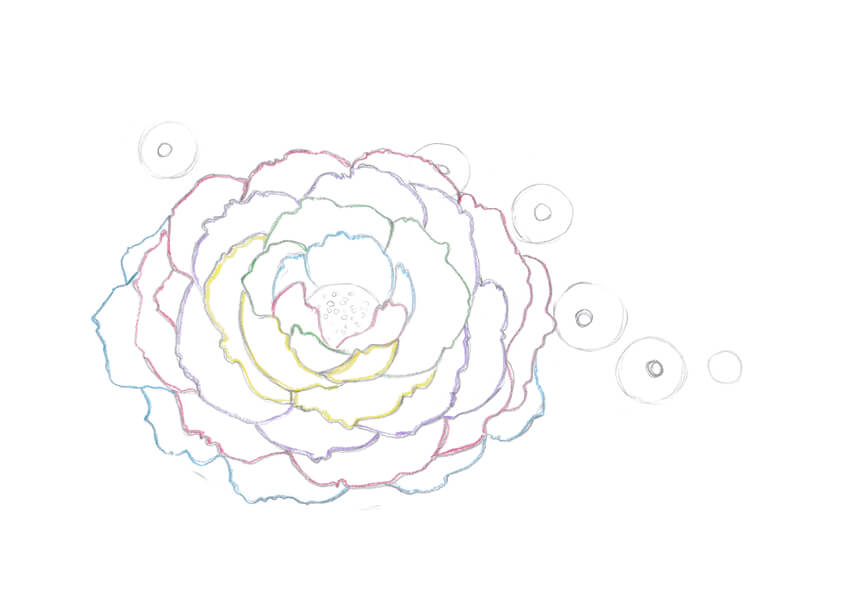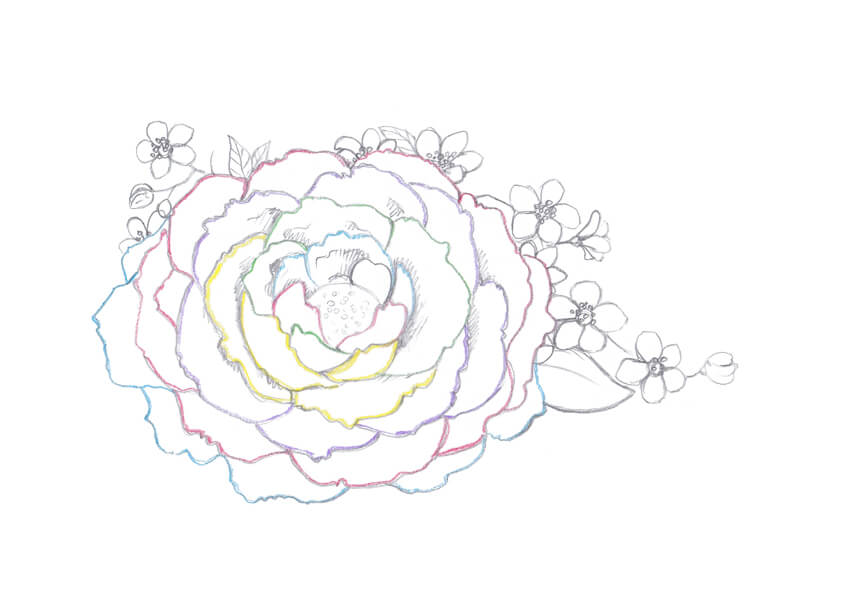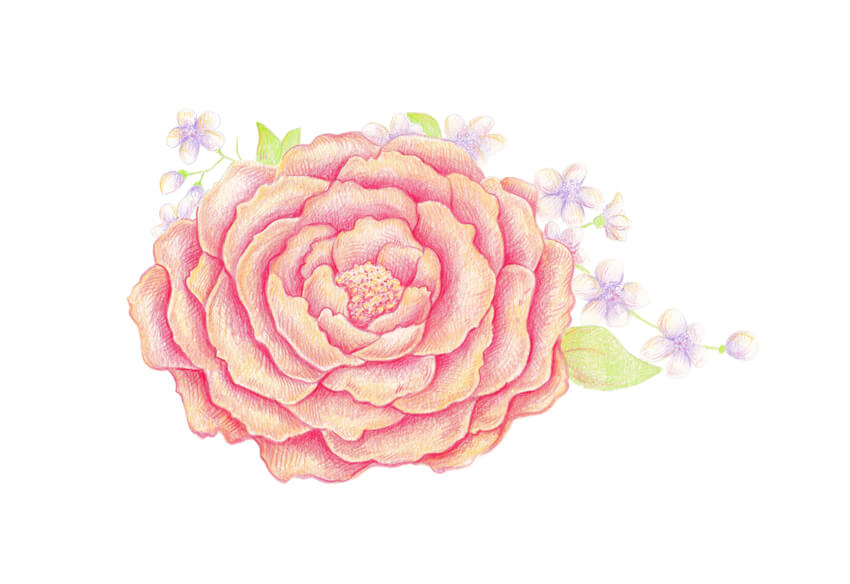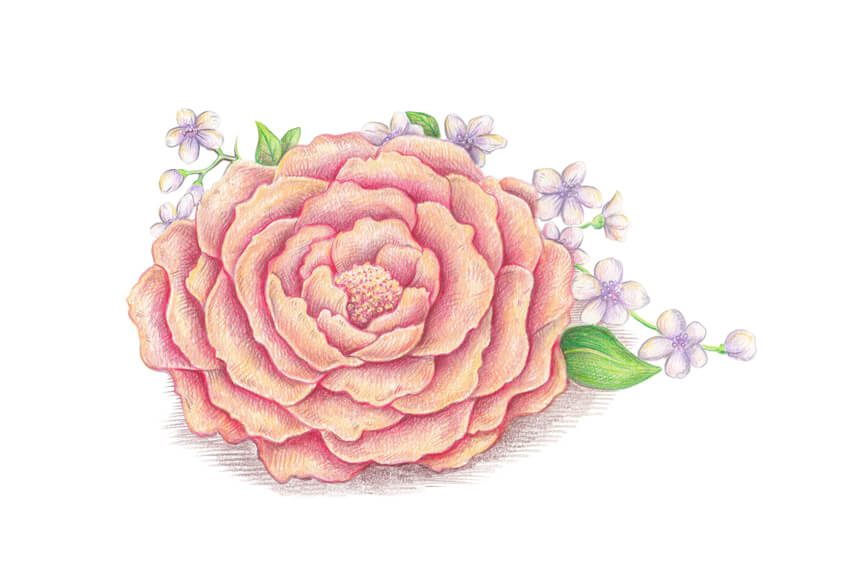Easy Colored Pencil Drawings Step by Step
In this tutorial, I'll show you the process of creating a nature-inspired artwork that depicts a peony and cherry blossoms, popular symbols of spring and flourishing.
To draw this beautiful floral composition, we will use colored pencils. They are a powerful artistic tool, and the great news is that pencils are very simple to use.
What You Will Need
- Two sheets of paper
- A graphite pencil (I recommend an HB type)
- A sharpener
And pencils of different colors:
- Chocolate brown
- Medium grey
- Raspberry red
- Rosy
- Lilac
- Rich blue
- Emerald green
- Light green
- Yellow
- Creamy (or light beige)
- White
My colored pencils are aquarelle, but this feature doesn't really matter. We'll work without washing the strokes.



1. How to Make a Pencil Sketch of the Flowers
Step 1
I outline the composition in a general way. With a pencil, I sketch an oval shape for the peony and smaller round shapes for the cherry flowers.



Step 2
I outline the core of the peony and fill it with small circles to mark the texture.



Step 3
I draw the first central petals of the peony. I also outline them with a blue pencil; I will be applying a new color to each new group of petals so you can easily differentiate them.
The option of adding any colors to your sketch is entirely up to you.



Step 4
I draw a couple of new petals in front of the existing ones and outline them with a red pencil.



Step 5
I draw an overlapping petal and a group of several rear petals. I mark them with the green color.



Step 6
I add several foreground petals and outline them with yellow.



Step 7
I imagine that the petals arrange themselves around the core of the flower, and add another layer. Then I mark the new group with a lilac pencil.



Step 8
One more layer of petals, and this time I outline them with red.



Step 9
The peony is almost complete. I add several more petals that hide underneath and outline them with a blue pencil.



Step 10
It's time to mark the central parts of the cherry blossoms. I draw small circles with a pencil.
It is not necessary to put these circles exactly into the geometrical centers of the flowers. The blossoms are facing in slightly different directions; moreover, they are organic objects that can't look equal.



Step 11
Each cherry flower has five petals, and I add them with pencil lines. It is also a great trick to diversify our floral composition with a small cherry bud.



Step 12
I add new details, such as a twig line, a couple of leaves, and new flowers.



Step 13
I draw a peony leaf in the foreground. I also add stamens of the cherry blossoms; they look like small circles.
Our pencil sketch is complete. You can leave it as it is now or mark shady areas, as I did for the central part of the peony, separating the petals with shadows.



2. How to Apply Pencil Strokes
Step 1
Colored pencils can help you achieve amazing results. There are several principles to remember, and one of them is the importance of creating layers of color. An overlap of tints and shades creates a much more interesting, impressive result than just one color.
The first way you can apply your tool is by making lines with soft rubbing strokes, holding your pencil at an angle. The lines can be directional...



… or rounded. This kind of stroke is perfect for smooth textures and a base color layer.



Step 2
Another excellent method is hatching. It is very similar to drawing with an ordinary pencil or pen; the point of your colored pencil should be sharp.
Hatching works best for adding details and drawing refined objects or textures.



3. How to Draw Flowers With Colored Pencils
Step 1
I make a clean copy of my pencil sketch, transferring only general contours with very light lines.
For this step, I recommend using a grey pencil from your colored pencils set, and not a graphite pencil. Lines made with a graphite pencil can mix with the color and make it seem dirty.
The lines that you see in the image below are barely visible in real life. I intensified them while editing the scan so you could see them distinctly.



Step 2
I use a pencil of the creamy color to cover the peony shape with soft rubbing strokes.



Step 3
With the lilac pencil, I add color to the central parts of the cherry flowers. I draw the hatches from the core to the petals.



Step 4
I apply the light green color to the leaves and the twig.



Step 5
I create an additional layer of theyellow color on the peony, accenting the upper parts of the petals.



Step 6
I add the rosy color, aiming at the dark places of the flower. It helps me in separating the petals one from another.
The point is about applying a body of color, not just a single line.



Step 7
I continue increasing the contrast with the rosy color.
The bending parts of the petals are spotlit, so I avoid making them too bright.



Step 8
I complete the process of applying strokes with the rosy pencil.
To create a unified look for the artwork, I also add several hatches to the cherry flowers.



Step 9
It is time to increase the contrast even more. I add the raspberry red color to the peony, accentuating the shadows between the petals.



Step 10
I apply hatches with the emerald green pencil to add details.



Step 11
I use the grey pencil to mark the contours of the cherry flowers. It's important not to overdo the drawing; the cherry blossoms should stay light.



Step 12
It is time for blending with the white pencil. I apply it on top of the grey strokes and shade them. The result is a smoother color transition.
This method is also known as burnishing, and I highly recommend using it in your drawings.



Step 13
I make my artwork feel more natural by adding thin hatches made with the brown pencil to the shadows. I also create a drop shadow under the peony.



Step 14
I apply an additional layer of thecreamy color to the peony. It looks more warm-colored now.



Step 15
I add some yellow strokes to the core of the peony and to the drop shadow.



Step 16
To make my artwork more interesting, I vary the range of colors with an inclusion of blue strokes.
I add thin hatches to the petals of the flowers and to the drop shadow.



Step 17
With the medium grey, I intensify the drop shadow.
It is also great to add thin hatches to the petals to balance this bright artwork.



Step 18
I evaluate my drawing. It looks nice enough, but I feel that adding several strokes of theblue color to the upper parts of the peony's petals is a great final touch.



Your Artwork Is Complete
Congratulations, we've created a beautiful spring artwork! I hope you became inspired by the flowers and enjoyed the process of drawing with colored pencils.
I wish you much success with this wonderful technique and your creative projects!



devillethusecomang.blogspot.com
Source: https://design.tutsplus.com/tutorials/how-to-draw-spring-flowers-with-colored-pencils--cms-28159
0 Response to "Easy Colored Pencil Drawings Step by Step"
Post a Comment